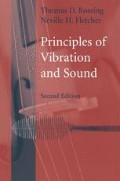Abstract
The wave propagation phenomena in fluids that we have examined in previous chapters have referred to waves in infinite or semi-infinite spaces generated by the vibrational motion of some small object or surface in that space. We now turn to the very different problem of studying the sound field inside the tube of a wind instrument. Ultimately, we shall join together the two discussions by considering the sound radiated from the open end or finger holes of the instrument, but for the moment our concern is with the internal field. We begin with the very simplest cases and then add complications until we have a reasonably complete representation of an actual instrument. At this stage, we will find it necessary to make a digression, for a wind instrument is not excited by a simple source, such as a loudspeaker, but is coupled to a complex pressure-controlled or velocity-controlled generator—the reed or air jet—and we must understand the functioning of this before we can proceed. Finally, we go on to treat the strongly coupled pipe and generator system that makes up the instrument as played.
Access this chapter
Tax calculation will be finalised at checkout
Purchases are for personal use only
Preview
Unable to display preview. Download preview PDF.
References
Ayers, R.D., Eliason, L.J., and Mahgerefteh, D. (1985). The conical bore in musical acoustics. Am. J. Phys. 53, 528–537.
Benade, A.H. (1959). On woodwind instrument bores. J. Acoust. Soc. Am. 31, 137–146.
Benade, A.H. (1968). On the propagation of sound waves in a cylindrical conduit. J. Acoust. Soc. Am. 44, 616–623.
Benade, A.H., and Jansson, E.V. (1974). On plane and spherical waves in horns with nonuniform flare. Acustica 31, 80–98.
Beranek, L.L. (1954). “Acoustics,” pp. 91–115. McGraw-Hill, New York; reprinted 1986, Acoustical Society Am., Woodbury, New York.
Eisner, E. (1967). Complete solutions of the “Webster” horn equation. J. Acoust. Soc. Am. 41, 1126–1146.
Fletcher, N.H., and Thwaites, S. (1988). Response of obliquely truncated simple horns: Idealized models for vertebrate pinnae. Acustica 65, 194–204.
Jahnke, E. and Emde, F. (1938). “Tables of Functions,” p. 146. Teubner, Leipzig, Reprinted 1945, Dover, New York.
Kergomard, J. (1981). Ondes quasi-stationnaires dans les pavillons avec partis viscothermiques aux parois: Calcul de l’impedance. Acustica 48, 31–43.
Levine, H., and Schwinger, J. (1948). On the radiation of sound from an unflanged pipe. Phys. Rev. 73, 383–406.
McIntyre, M.E., Schumacher, R.T., and Woodhouse, J. (1983). On the oscillation of musical instruments. J. Acoust. Soc. Am. 74, 1325–1345.
Morse, P.M. (1948). “Vibration and Sound,” 2nd ed pp. 233–288. McGraw-Hill, New York; reprinted 1976, Acoustical Society of Am., Woodbury, New York.
Morse, P.M., and Feshbach, H. (1953). “Methods of Mathematical Physics,” Vol. 1, pp. 494–523, 655–666. McGraw-Hill, New York.
Morse, P.M., and Ingard, K.U. (1968). “Theoretical Acoustics,” pp. 467–553. McGrawHill, New York. Reprinted 1986, Princeton Univ. Press, Princeton, New Jersey.
Olson, H.F. (1957). “Acoustical Engineering,” pp. 88–123. Van Nostrand-Reinhold, Princeton, New Jersey.
Pyle, R.W. (1975). Effective length of horns. J. Acoust. Soc. Am. 57, 1309–1317.
Rayleigh, Lord (1894). “The Theory of Sound,” 2 vols. Macmillan, London. Reprinted 1945. Dover, New York.
Salmon, V. (1946a). Generalized plane wave horn theory. J. Acoust. Soc. Am. 17, 199–211.
Salmon, V. (1946b). A new family of horns. J. Acoust. Soc. Am. 17, 212–218. Schumacher, R.T. (1981). Ab initio calculations of the oscillations of a clarinet. Acustica 48, 71–85.
Webster, A.G. (1919). Acoustical impedance, and the theory of horns and of the phonograph. Proc. Nat. Acad. Sci. (US) 5, 275–282.
Author information
Authors and Affiliations
Rights and permissions
Copyright information
© 2004 Springer Science+Business Media New York
About this chapter
Cite this chapter
Rossing, T.D., Fletcher, N.H. (2004). Pipes and Horns. In: Principles of Vibration and Sound. Springer, New York, NY. https://doi.org/10.1007/978-1-4757-3822-3_8
Download citation
DOI: https://doi.org/10.1007/978-1-4757-3822-3_8
Publisher Name: Springer, New York, NY
Print ISBN: 978-1-4419-2343-1
Online ISBN: 978-1-4757-3822-3
eBook Packages: Springer Book Archive

